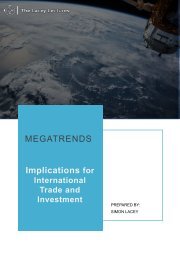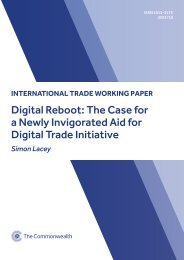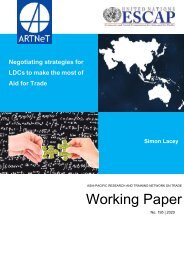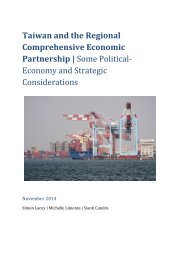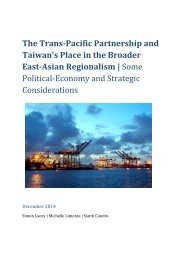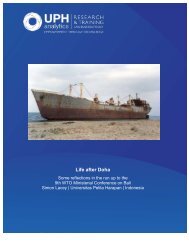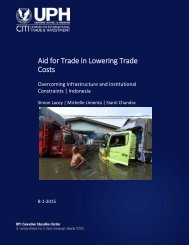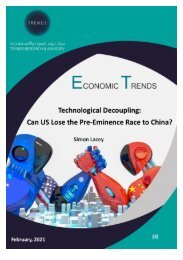Cross Border Data Flows: The impact of data localisation on IoT
This industry report seeks to shed new light on the costs of imposing data localization requirements or other restrictions on cross-border data flows with respect to the important economic growth likely to result from the uptake and adoption of IoT in manufacturing, agriculture and other important sectors of the economy. It chooses 3 large emerging markets in order to showcase its model, namely Brazil, Indonesia and South Africa.
This industry report seeks to shed new light on the costs of imposing data localization requirements or other restrictions on cross-border data flows with respect to the important economic growth likely to result from the uptake and adoption of IoT in manufacturing, agriculture and other important sectors of the economy. It chooses 3 large emerging markets in order to showcase its model, namely Brazil, Indonesia and South Africa.
You also want an ePaper? Increase the reach of your titles
YUMPU automatically turns print PDFs into web optimized ePapers that Google loves.
CROSS-BORDER DATA FLOWS: THE IMPACT OF DATA LOCALISATION ON IOT<br />
<strong>IoT</strong> enables different paths for growth for emerging ec<strong>on</strong>omies.<br />
<str<strong>on</strong>g>The</str<strong>on</strong>g> CGE model generates interesting results across<br />
different emerging ec<strong>on</strong>omies from the productivity<br />
increase. Whereas the adopti<strong>on</strong> <str<strong>on</strong>g>of</str<strong>on</strong>g> <strong>IoT</strong> and related<br />
technologies was universally beneficial to GDP across<br />
all the three countries surveyed, we see export-led<br />
growth in Brazil as opposed to c<strong>on</strong>sumpti<strong>on</strong> and<br />
investment-driven growth in South Africa.<br />
This study has deliberately focused <strong>on</strong> three<br />
emerging ec<strong>on</strong>omies in different regi<strong>on</strong>s with varying<br />
industrial structures and demographics, and which<br />
find themselves <strong>on</strong> different growth trajectories. <str<strong>on</strong>g>The</str<strong>on</strong>g><br />
varying paths for growth presented by <strong>IoT</strong> deployment<br />
show how the ec<strong>on</strong>omy-wide deployment <str<strong>on</strong>g>of</str<strong>on</strong>g> <strong>IoT</strong> brings<br />
positive benefits to the ec<strong>on</strong>omy regardless <str<strong>on</strong>g>of</str<strong>on</strong>g> regi<strong>on</strong>,<br />
size or growth model.<br />
Results are c<strong>on</strong>sistent across all countries.<br />
<str<strong>on</strong>g>The</str<strong>on</strong>g> TFP <str<strong>on</strong>g>impact</str<strong>on</strong>g>s derived from the GSMA Intelligence<br />
survey are c<strong>on</strong>siderable. <str<strong>on</strong>g>The</str<strong>on</strong>g>y are further augmented<br />
by the dynamic effects in the ec<strong>on</strong>omy and the ‘at the<br />
border’ effects implied by the WTO study, especially in<br />
the case for South Africa.<br />
Overall, these large numbers are explained by the<br />
underlying methodology <str<strong>on</strong>g>of</str<strong>on</strong>g> the studies we rely <strong>on</strong> for<br />
our ec<strong>on</strong>omic shocks, but should not affect the relative<br />
importance <str<strong>on</strong>g>of</str<strong>on</strong>g> cross-border <str<strong>on</strong>g>data</str<strong>on</strong>g> flows or the significant<br />
<str<strong>on</strong>g>impact</str<strong>on</strong>g> <str<strong>on</strong>g>of</str<strong>on</strong>g> DLRs. <str<strong>on</strong>g>The</str<strong>on</strong>g> results <strong>on</strong> <str<strong>on</strong>g>data</str<strong>on</strong>g> flow c<strong>on</strong>tributi<strong>on</strong>s<br />
(and costs <str<strong>on</strong>g>of</str<strong>on</strong>g> <str<strong>on</strong>g>data</str<strong>on</strong>g> <str<strong>on</strong>g>localisati<strong>on</strong></str<strong>on</strong>g>) are c<strong>on</strong>sistent and<br />
within a relatively close band regardless <str<strong>on</strong>g>of</str<strong>on</strong>g> the size or<br />
type <str<strong>on</strong>g>of</str<strong>on</strong>g> shock introduced in the model.<br />
Costs <str<strong>on</strong>g>of</str<strong>on</strong>g> DLRs and similar restricti<strong>on</strong>s are increasing.<br />
In additi<strong>on</strong>, as <strong>IoT</strong> adopti<strong>on</strong> rates increase and<br />
value chains and producti<strong>on</strong> networks adapt and<br />
rec<strong>on</strong>figure themselves to take advantage <str<strong>on</strong>g>of</str<strong>on</strong>g> these<br />
new technologies, the cost implicati<strong>on</strong>s <str<strong>on</strong>g>of</str<strong>on</strong>g> imposing<br />
DLRs and similar restricti<strong>on</strong>s <strong>on</strong> cross-border <str<strong>on</strong>g>data</str<strong>on</strong>g><br />
flows will <strong>on</strong>ly increase. Any such measures need<br />
to be carefully c<strong>on</strong>ceived and narrowly formulated,<br />
with a view to implementing them in such a way that<br />
is minimally disruptive to the <str<strong>on</strong>g>data</str<strong>on</strong>g> requirements <str<strong>on</strong>g>of</str<strong>on</strong>g><br />
business and their need to collect, process and transfer<br />
<str<strong>on</strong>g>data</str<strong>on</strong>g> across multiple jurisdicti<strong>on</strong>s.<br />
Although the significant GDP losses generated in this<br />
study are not directly comparable to previous studies<br />
<strong>on</strong> DLRs (ECIPE 2014), the results in these studies<br />
indicate substantially higher costs from DLRs due to<br />
higher <str<strong>on</strong>g>data</str<strong>on</strong>g> intensity in the ec<strong>on</strong>omy brought <strong>on</strong> by <strong>IoT</strong><br />
and 5G. <str<strong>on</strong>g>The</str<strong>on</strong>g> societal costs <str<strong>on</strong>g>of</str<strong>on</strong>g> disrupting c<strong>on</strong>nectivity<br />
and network provisi<strong>on</strong> likewise increase.<br />
Network and regulati<strong>on</strong>s must be minimally trade-restrictive.<br />
In c<strong>on</strong>clusi<strong>on</strong>, policymakers and business leaders<br />
cannot afford to be complacent, but need to start<br />
thinking very seriously about what steps they plan<br />
to take to facilitate and accelerate the adopti<strong>on</strong> and<br />
implementati<strong>on</strong> <str<strong>on</strong>g>of</str<strong>on</strong>g> <strong>IoT</strong> and related technologies. By<br />
the same token, they need to avoid any measures<br />
that undermine the efficiency gains and cost savings<br />
that these technologies can unleash. In particular,<br />
DLRs and other restricti<strong>on</strong>s <strong>on</strong> cross-border<br />
<str<strong>on</strong>g>data</str<strong>on</strong>g> flows should <strong>on</strong>ly be applied when they are<br />
absolutely essential and implemented in a way that is<br />
minimally trade-restrictive.<br />
Overall, the results show that DLRs and similar<br />
restricti<strong>on</strong>s <strong>on</strong> cross-border <str<strong>on</strong>g>data</str<strong>on</strong>g> flows can significantly<br />
cut into the efficiency gains achieved by adopting and<br />
implementing <strong>IoT</strong> and related technologies. Restricti<strong>on</strong>s<br />
<strong>on</strong> cross-border <str<strong>on</strong>g>data</str<strong>on</strong>g> flows significantly raise costs for<br />
businesses while also lowering their pr<str<strong>on</strong>g>of</str<strong>on</strong>g>itability — and<br />
the tax revenues they pay to governments.<br />
25




